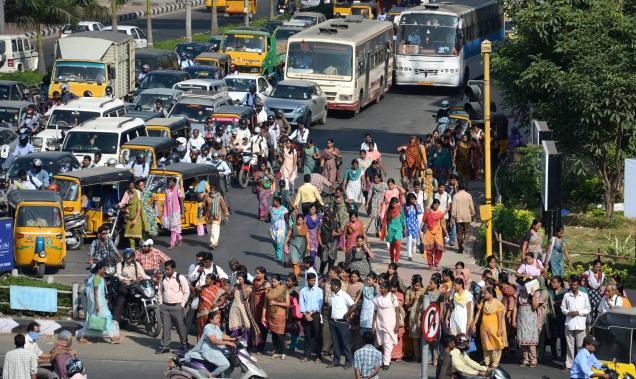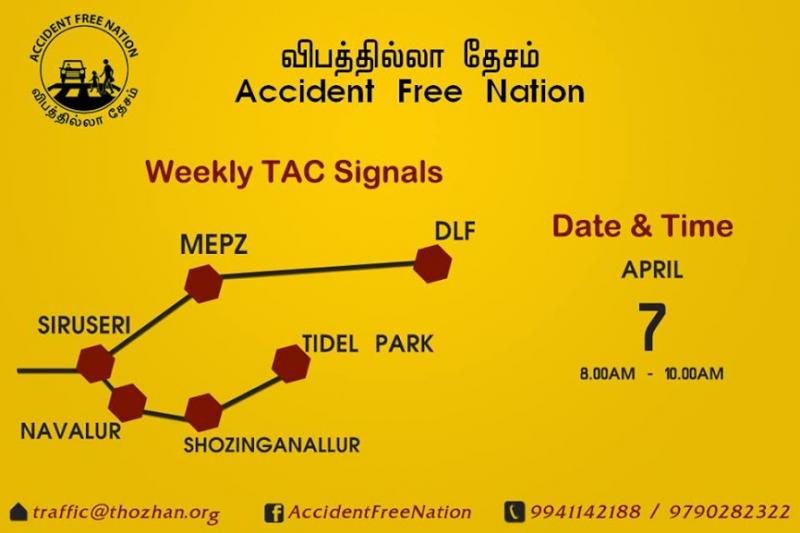Search ‘Indian traffic’ or ‘India driving’ on the Internet and what you find is a load of articles, memes, and videos on the madness that is driving in India. While these are amusing to read or watch, they underscore how dangerous Indian roads. On average 17 people die every hour on India’s roads. Most of these deaths (not to mention serious injuries) are the drivers’ fault, says Government of India data (Road Accidents in India 2015). As road users in India, we tend to shrug off the bad driving, thinking that is just the way it is. I know because that is how I used to think.
A year ago, CAG began advocacy work on road safety. In addition to advocacy for a strong legislation on road safety we also began public awareness programmes. As a part of this, our team volunteered with Thozhan, a voluntary group that conducts road safety awareness interventions at various traffic intersections in Chennai.
Traffic Awareness Campaign
The campaigns take place every Thursday from 8 to 10 am and cover major traffic signals like Tidel Park, Shozinganallur, Navalur, Siruseri, Thooraipakkam, MEPZ, and DLF on the Old Mahabalipuram Road (OMR) in South Chennai, which is home to many IT companies and colleges. Volunteers for the awareness campaign are invited through Facebook.
Image 1: Tidel park signal
At each of the signals there is a lead person who gives the volunteers a brief introduction on the global and Indian traffic accident scenario, and how to react on the road while driving or crossing it. The person highlights that rules are to be obeyed and safety steps, such as wearing a helmet while driving a bike or wearing a seatbelt in a car, are to be followed. All the volunteers sing the song, “Tamil Vazhthu” in praise of Tamil Nadu and take a pledge related to road safety. Volunteers are instructed on how to control traffic, help pedestrians, and share road safety information with road users. Reflective jackets and face masks are provided for volunteers’ safety. In addition they are instructed to carry placards and pamphlets. Volunteers are engaged in managing the traffic and sharing road safety messages with the public for one and half hours, at the end of which they share their experience and feedback received from public. The campaign ends with singing of the national anthem.
Image 2: Location of Thozhan’s Traffic Awareness Campaign (Source: Thozhan)
My experience
I participated at the campaign at the Tidel park signal. On my first day, after wearing the jacket and mask, and hanging placards around my neck, I picked up some pamphlets and plunged into the busy traffic. I started advising pedestrians to walk on sidewalks. Also I requested bike riders to wear helmets, and car users to wear seat belts. Many road users had to be reminded not to use the phone while driving. I was shocked to see that most helmets were worn by the bike mirrors rather than on the riders’ heads! There were others who wore the helmets but had not fastened the strap properly. In the busy traffic, I observed many things like people using their mobiles (either the hands-free or the instrument itself) while driving. Pedestrians, too, were using the mobile instead of watching where they were going. Most pedestrians also were not using the pedestrian crossing, and were instead crossing the road wherever they felt like. The traffic was so heavy that I could not approach these pedestrians who crossed the road by weaving through traffic. Watching the traffic, I was not confident about running across to talk to people who were taking such risks. Once the campaign was over, I shared my experience with the team and received feedback.
After participating a few times in the weekly campaign, I found that I was noticing people’s behavior on the road, recognising the various ways they violate the rules and could almost predict what they would do next! It has also made me more aware of how I drive and taught me to calm down and take fewer risks while driving.


Add new comment